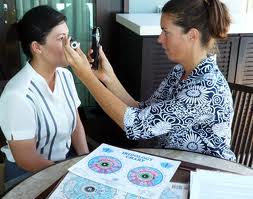
HBI HEALTH & HOMOEOPATHY CENTRE
Promoting Homeopathy All Malaysia Over & Virtually
HOMOEOPATHY & IRIDOLOGY
by Mohamed Hatta Abu Bakar, HMD
(The British Institute of Homoeopathy)
Index
IRIDOLOGY 3

SIMPLE CHECKS
A layman practitioner should be able to check and identify the signs just by using a small centre-focused torch light. This can be done by putting the torch light to the left (when observing the left iris) or to the right (when observing the right iris) while the practitioner confront face to face with the person. This is one of the number of ways used by the iridologists to identify the signs when using a simple torch light.
But ‘never leave a torch light too long over the eye.’ In fact, DO NOT EXPOSE THE EYE TO LIGHT FOR MORE THAN 10 SECONDS at a time. In every iris diagnosis , after 10 seconds a practitioner is advised to move away the torch light, writing something down, let the eye relax, then only come back again. If not, it is better to take slides or pictures of the patient irises and analyse.
SPECIAL SIGNS
There are many signs and areas that an iridologist look for when making a diagnosis. A homoeopathic practitioner may not be interested in all those signs as homoeopaths only interested in identifying and recognizing symptoms of patients. Therefore, to use iridology as a diagnostic tool, I suggest that it is enough for a homoeopath to know the basic signs which are known as “special signs.” In view of this, it may be a good idea to supply such knowledge to students of homoeopathy as part of practical diagnosis or part of homoeopathy curriculum.
The special signs which are of particular importance are six altogether, i.e. sodium ring, scurf rim, the lymphatic rosary, nerve rings, radii solaris and psoric spots.
Virtually published for MHCL from: http://www.homeolibrary.com